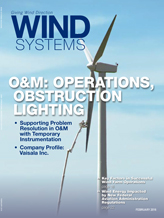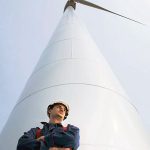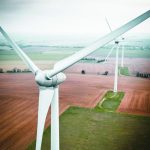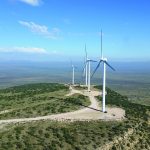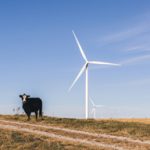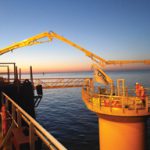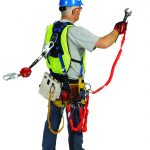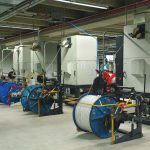The purpose of a measurement system is to provide the quantitative data necessary to make educated decisions. In the wind energy sector, temporary measurement methods are often utilized with wind turbines due to the large scale of components, remote location, and dozens of turbines making up a single wind power plant. The measurements, analysis, and interpretations support the owners and operators to better understand the behavior and reliability of the machines so that critical decisions can be made to optimize O&M cost.
 Temporary measurements can be as simple as using a scale to measure distance, while temporary instrumentation systems may record measurements at 25,000 samples per second from multiple sensors. Some common examples of temporary measurements (load measurement on the main shaft, vibration measurement on the gearbox, etc.) on a typical wind turbine drivetrain are shown in Figure 1.
Temporary measurements can be as simple as using a scale to measure distance, while temporary instrumentation systems may record measurements at 25,000 samples per second from multiple sensors. Some common examples of temporary measurements (load measurement on the main shaft, vibration measurement on the gearbox, etc.) on a typical wind turbine drivetrain are shown in Figure 1.

Wind turbine owners and operators are beginning to use temporary instrumentation systems to measure wind turbine loads in assessing OEM-offered performance and to make modifications that will increase a wind farm’s annual energy production (AEP). Such instrumentation systems include blade modifications (i.e., vortex generators and tip extensions), micro-siting, and turbine controller software upgrades. While increased AEP is tempting to the owner, it comes with the uncertainty of negatively affecting the loads on the drivetrain. Increased loads could potentially reduce key component lives or cause premature failures. Some operators are choosing to validate the OEM’s modifications by measuring the main shaft torque and bending, which can be supported by use of data loggers and strain gauges, which can often be installed uptower in one day (as shown in Figure 2).

The measurement period is continuous for multiple weeks, ideally before and after the performance modification. Sometimes the measurement is conducted on multiple turbines on the same site for neighbor turbine comparison. The data is remotely accessed over cellular network and analyzed for torque, tilt, and yaw moments in time series, frequency spectrums, and load distribution diagrams (LDD). The typical and unusual loading events will be identified and processed. Combined with SCADA data analysis, the operating parameters can be examined during periods of unusual loading, such as peak and transient loads. The detailed measurement and processing programs can be based on the recommendations from IEC 61400-13, which is a standard created by the International Electrotechnical Commission (IEC) that describes the measurement of fundamental structural loads on wind turbines for the purpose of the load simulation model validation. In some applications, measurements have to be repeated multiple times to reduce the statistical uncertainty due to the stochastic character of the site conditions. An example of measured torque and bending moment can be found in Figure 3.

Temporary measurements are also often used during failure root cause analysis (RCA) to determine primarily failure cause and corrective action to increase the O&M efficiency through targeted work planning. The results can also improve the value of the failure data and support the communication with the turbine OEMs. Failures of wind turbine components can be costly, especially if impacting a batch or an entire fleet. A cause and effect exercise, as shown in Figure 4, can be used to identify all possible causes and a strategy for addressing each of them. Temporary measurement systems can be used to investigate the more complex contributors to the failure. Relatively simple static measurements with dial indicators, digital calipers, and laser measurement can determine the drivetrain alignment, mainframe mounting position, and bearing preload. Specialized data acquisition systems can be used to collect dynamic measurements while a turbine is operating. For example, Romax’s portable vibration systems (PVS) can be used to assess rotor imbalance or shaft misalignments. Proximity sensors can monitor component displacements, such as the gearbox motion relative to the mainframe. As previously mentioned, measuring the main shaft torque and bending can also benefit an RCA investigation by comparing the load that the failed gearbox is undertaking with that in a neighbor healthy turbine.

In some instances, a simple physical dimension is desired, yet the limited access or large size of wind turbine components can make collecting these measurements a difficult task. The planetary stage is usually a challenging assembly for measurement and fault detection, and it is more expensive for maintenance and replacement. It is also more complicated than the other stages, as more gears and bearings and undertake higher, more complicated loads from the rotor side. For example, a planet gear tooth fracture, such as in Figure 5, was detected by Romax’s PVS and later confirmed by borescope inspection. In the frequency spectrums in Figure 6, pronounced magnitudes can be found from the suspect gearbox (in black) at the repeating harmonics at planet gear rotation frequency compared with the healthy gearbox spectrum (in green). Romax monitoring engineers recommended that all planet gears and the sun gear be inspected at a complete 360-degree circumference, and the failure was found on one of the planet gears.


The ability to simply measure the length, width, and depth of the feature could be enough to responsibly manage the continued operation of the gearbox. A practical method is to take a surface impression replica, meaning a fast curing silicon applied to the gear or bearing surface. The sample can then be easily measured by a variety of equipment in the convenience of a laboratory, as shown in Figure 7. Repeat measurements can establish a rate of progression, hence the remaining life of the component. The ability to quantify the defect eliminates subjective speculation, enabling the turbine operator to make educated decisions in asset management.

 The use of temporary measurement systems is a valuable tool for wind turbine owners and operators. O&M costs can be reduced by mitigating, or even preventing, damage. There is also the opportunity for significant time savings, as well as no upfront capital that’s often associated with installing permanent equipment. In some instances, a wind farm’s AEP can be increased where the role of the instrumentation is to confirm that the drivetrain loads are still acceptable. Temporary measurement systems can validate design changes or determine the cause of fleet-wide failures. It is ultimately about generating quantitative data for solving today’s wind turbine problems.
The use of temporary measurement systems is a valuable tool for wind turbine owners and operators. O&M costs can be reduced by mitigating, or even preventing, damage. There is also the opportunity for significant time savings, as well as no upfront capital that’s often associated with installing permanent equipment. In some instances, a wind farm’s AEP can be increased where the role of the instrumentation is to confirm that the drivetrain loads are still acceptable. Temporary measurement systems can validate design changes or determine the cause of fleet-wide failures. It is ultimately about generating quantitative data for solving today’s wind turbine problems.
















